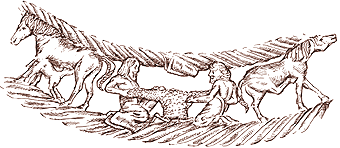
ABRIDGED HISTORY OF UKRAINE - PART ONE
Loosely translated and abridged by George Skoryk from
"HISTORY OF UKRAINE" by Mykhaylo Hrushevs'kyi

I. PERIOD PRIOR TO KYIVAN STATE.
During the Miocene Period in Tertiary Age of Cenozoic Era, some 12
million years ago, most of Ukraine was covered by sea. At the end
of this period the seas receded to the approximately present day
coasts of Black, Azov and Caspian seas to form one big sea. The
climate was very hot and humid, lush vegetation covered the ground
and there were all kinds of large animals and birds.
Then, during the Pliocene period, some 6 million years ago, the
climate began to cool. Many plants and animals disappeared and
only those, which could adapt to lower temperatures, such as fury
mammoths and rhinoceroses, remained. Later the ground froze up and
soon ice sheets covered most of the northern part of Ukraine. That
was the Pleistocene Period in Quaternary Age of Cenozoic Era,
about 1 million years ago,
Commonly known as the Ice Age.
When the ice retreated, life started to reappear. Traces of human
habitation in Ukraine, dating back at least 30 thousand years,
became evident during geological excavations. Primitive stone
tools, carvings from mammoth tusks, arrow heads made from flint
stone, earthenware, bronze tools and weapons and gold jewelry
found in different layers of earth enabled geologists to
reconstruct the way of life of early man.
At first, during Old Stone Age (Paleolithic Age), humans did not
have domestic animals, could not make utensils and relied
exclusively on hunting and fishing. Then, gradually, during Middle
Stone Age (Mesolithic Age) they began to make stone tools and
weapons.
Later, during Late Stone Age (Neolithic Age), they began to make
utensils from earth, kept domestic animals for milk and meat,
constructed dwellings and cultivated the soil.
During the Bronze Age, about 3000 BC, and Iron Age, about 1000 BC,
metal agricultural implements and weapons came into use; crafts
and commerce began to develop.
From 7th century BC Greeks started to colonize the coast of the
Black Sea. They traded wine, oil, and textiles, silver and gold
wares and utensils with local tribes for grain and hides but they
also engaged in slave trade. They introduced Greek Culture and
many tribes adopted Greek customs and religion. The Greek
historian Herodotus documented information about Ukraine of this
period.
There were numerous tribes in Ukraine, some nomadic, some
agricultural; most of the time at war with each other. The oldest
known main inhabitants of Ukraine were Cimmerians. They were
replaced in 5th century BC by Scythians, who ruled till 2nd
century BC; Sarmatian tribes then replaced them. Later in 1st
century AD the tribesmen of the dominant horde were called Alanis.

Sword and Scabbard with Boar's Head, 4th century BCE
These tribes, mainly of Iranian origin, were conquered in 2nd
century AD by German tribe called Goths from Baltic region. About
370 AD, the first Asian horde of Huns, on their way to western
Europe, defeated and expelled Goths from Ukraine. They were
followed in 5th-6th centuries by the Bulgars and Avars.
The exact origin of Slav people is unknown, but it can be assumed
that they existed for a long time before they were mentioned in
historical records by Romans in 1st century AD. A very strong Slav
tribe called Wends developed in 4th century; their settlements
extended from central Ukraine up to Baltic Sea. When in the 6th
century they moved to Southwest Germany, Antes became the dominant
tribe in Ukraine.
At different times they were fighting with and against Goths,
Huns, Avars, Greeks and Slovyans. Although ruled by princes, they
also had people's councils and tribal elders.
According to legends, Kyiv was founded in the 5th century by three
brothers Kiy, Shchek and Khoriv and their sister Lebid; later Kyiv
was reigned by princes (or chieftains) Askold and Dyr.
At end of 7th century AD, Khazars established themselves on
Caspian steppes, which somewhat shielded Ukraine from other Asian
hordes. Also in the 7th century Greeks left Black Sea shores, thus
causing a considerable gap in the documented history of Ukraine.
Khazar control of the steppe was breached in the late 9th century
by the Magyars, who later were replaced by Pechenegs and then by
Polovetsians as dominant tribes.
|